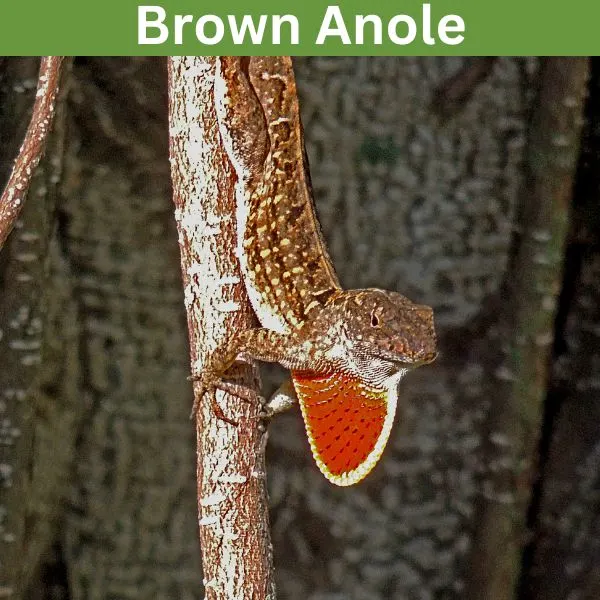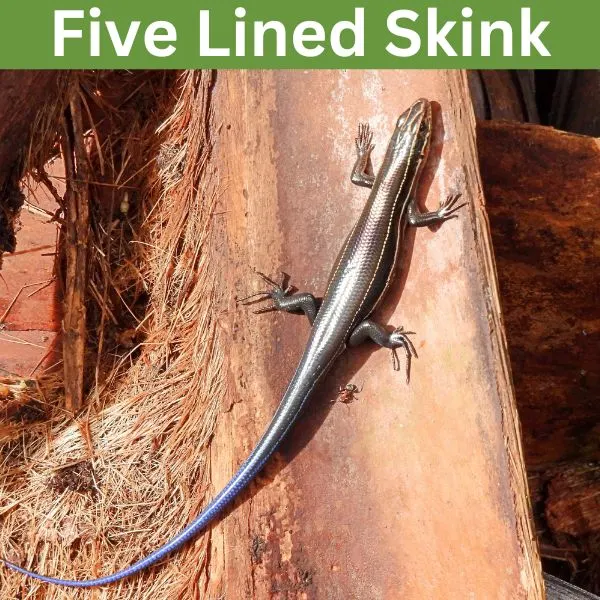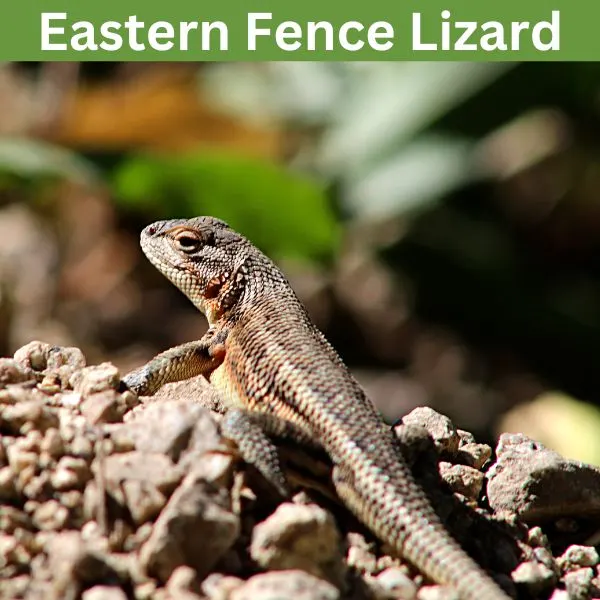In New York there are 5 lizard species that live within the state, with 3 of them being native to the region. Lizards are very sneaky reptiles, and do not like to interact with humans very often. Their secretive nature, speed, and camouflage may make it hard for you to spot lizards in the wild. If you know when, and where to look you may find it easier to see some of the lizards near you.
Here we will cover the 5 lizard species that live in New York, but also go over some interesting facts about them. Lizards are very unique reptiles, and you may find differences in the various species size, scales, behavior, and colors. Let’s take a look at the few lizards of New York, and what interesting things you should know about them.
Table of Contents
Different Species of Lizards in New York
Dactyloidae
1. Brown Anole

- Experience Level: Beginner
- Family: Dactyloidae
- Scientific Name: Anolis sagrei
- Other Names: Bahaman Anole, Cuban Brown Anole
- Adult Size: 5 to 9 in. (12 to 22.86 cm)
- Lifespan: 5 years
- Average Price Range: $10
Brown anoles are an invasive lizard that is originally from Cuba, but have managed to find their way in New York, and other states. These lizards are not common in the state, but have managed to make their way into urban areas due to trade with other countries.
Brown anoles are large when fully grown, and get their name from their brown coloring. These lizards are capable of changing their shade to better blend into their environment. Brown anoles have a gray, to tan coloring, with males having an orangish dewlap under their chin.
These lizards are mainly active in warm, and tropical environments, and can be seen during the day. During the spring to fall breeding seasons males can get very territorial. Due to the hardness, and quick breeding of this lizard they are able to become invasive to several regions around the world.
Scincidae
2. Northern Coal Skink

- Experience Level: Intermediate
- Family: Scincidae
- Scientific Name: Plestiodon anthracinus
- Other Names: n/a
- Adult Size: 5.1 to 7.1 in. (13 to 18 cm.)
- Lifespan: 6 years
- Average Price Range: n/a
In New York northern coal skinks are very rare, and have only been documented in a few regions within the state. These lizards live in woodlands, and wetland habitats. They are mainly found in the eastern United States, but their populations are scattered.
Coal skinks are medium sized, with smooth scales. They have a tan, black, or gray coloring, with a dark stripe that runs down their side. These lizards may have a blue tail when born. Males may get red coloring around their face in the breeding season.
Northern coal skinks breed in the spring, laying around 8 eggs. They feed on insects, and other small invertebrates, mainly active in the day. These lizards are very secretive, and are often seen under rocks, logs, or other debris.
3. Common Five-lined Skink

- Experience Level: Intermediate
- Family: Scincidae
- Scientific Name: Plestiodon fasciatus
- Other Names: American five-lined skink
- Adult Size: 4.9 to 8.5 in. (12.5 to 21.5 cm)
- Lifespan: 6 years
- Average Price Range: $12
Common five-lined skinks are found in a small range within New York. They are mainly seen in dry areas, with woodlands, or rocky terrains. These lizards are named after the five lines that run down their back. They have small scales, with a smooth appearance.
Common five-lined skinks have yellowish lines that run down their body. When born like other skinks these lizards have a bright blue tail, which they can drop to escape predators. Males gain a reddish jaw in the breeding season, which occurs in spring and summer.
Insects, and other small invertebrates are what this lizard eats. They are mainly active in the day, with predators like birds, small mammals, and snakes feeding on this lizard. Common five-lined skinks hibernate in the winter, and hide in places like burrows, or under debris until temperatures warm.
Lacertidae
4. Italian Wall Lizard

- Experience Level: Beginner
- Family: Lacertidae
- Scientific Name: Podarcis siculus
- Other Names: Ruin lizard
- Adult Size: 3.5 in. (9 cm.)
- Lifespan: 13 years
- Average Price Range: n/a
The Italian wall lizard is an invasive lizard originally from the Mediterranean area, introduced to the areas in the 1960s. This lizard lives in urban, rocky, and shrubby habitats. They are adapted to live in urban areas, and spend their time feeding on small invertebrates, and other foods like insects.
Italian wall lizards come in various colors, and have a green, brown, and yellowish shade on them. These lizards can have blotches, or stripes on their body. Their scales are very small, and granular.
These lizards are very hardy, and are believed to have been released from pets, which is what caused them to be invasive. They are illegal in the state, since they can negatively impact the environment.
Phrynosomatidae
5. Eastern Fence Lizard

- Experience Level: Intermediate
- Family: Phrynosomatidae
- Scientific Name: Sceloporus undulatus
- Other Names: Northern fence lizard, gravid lizard, pine lizard
- Adult Size: 4 to 6 inches (10.16 to 15.24 cm.)
- Lifespan: 5 to 7 years
- Average Price Range: $20
Eastern fence lizards are very rare in New York, but are native to the eastern United States. These lizards live in pine forests, grasslands, and shrubland habitats. The population of the eastern fence lizard is stable, but in New York these lizards have seen a considerable decline.
Gray with roughly keeled scales are the color of this lizard. Females have dark wavy markings on their body. Males in the breeding season may have a blue shade on their belly. Eastern fence lizards are medium-sized, and they have large claws which help them climb.
This lizard is active in the day, and enjoys basking in the sun on things like large rocks, or fences. Their diet consists of insects like beetles, ants, grasshoppers, and spiders.
What is the largest lizard in New York?
Skinks are one of the largest lizards that live in New York, and when measured with their tail can grow more than 6 in. in length. A lizard size varies, and depends on factors like its age, species, sex, and nutrition.
Are lizards common in New York?
New York is home to around 3 lizard species that are native to the state, with the other two being invasive. The months from spring to fall are when lizards are most active. In New York lizards are not very common as in other states, but when looking in the right times, and areas they can be found.
Wrapping up
There are 5 lizard species that live in New York, and the state is one of the places in the United States with only a few native species. Other reptiles you may find in New Jersey include snakes, and turtles. You can find an abundance of wildlife in New York, and lizards are just one animal that makes up the overall ecosystem.
Some lizards make good pets, but before getting one you should fully research what a speed needs in its diet, and home. The more you learn about lizards the easier it is to find them in the wild. New York is filled with amazing habitats like woodland, and wetlands which are just a few of the places lizards live.
Other exotic species in New York
- Turtles in New York
- Snakes in New York
- Salamanders in New York
- Frogs in New York
- Spiders in New York
